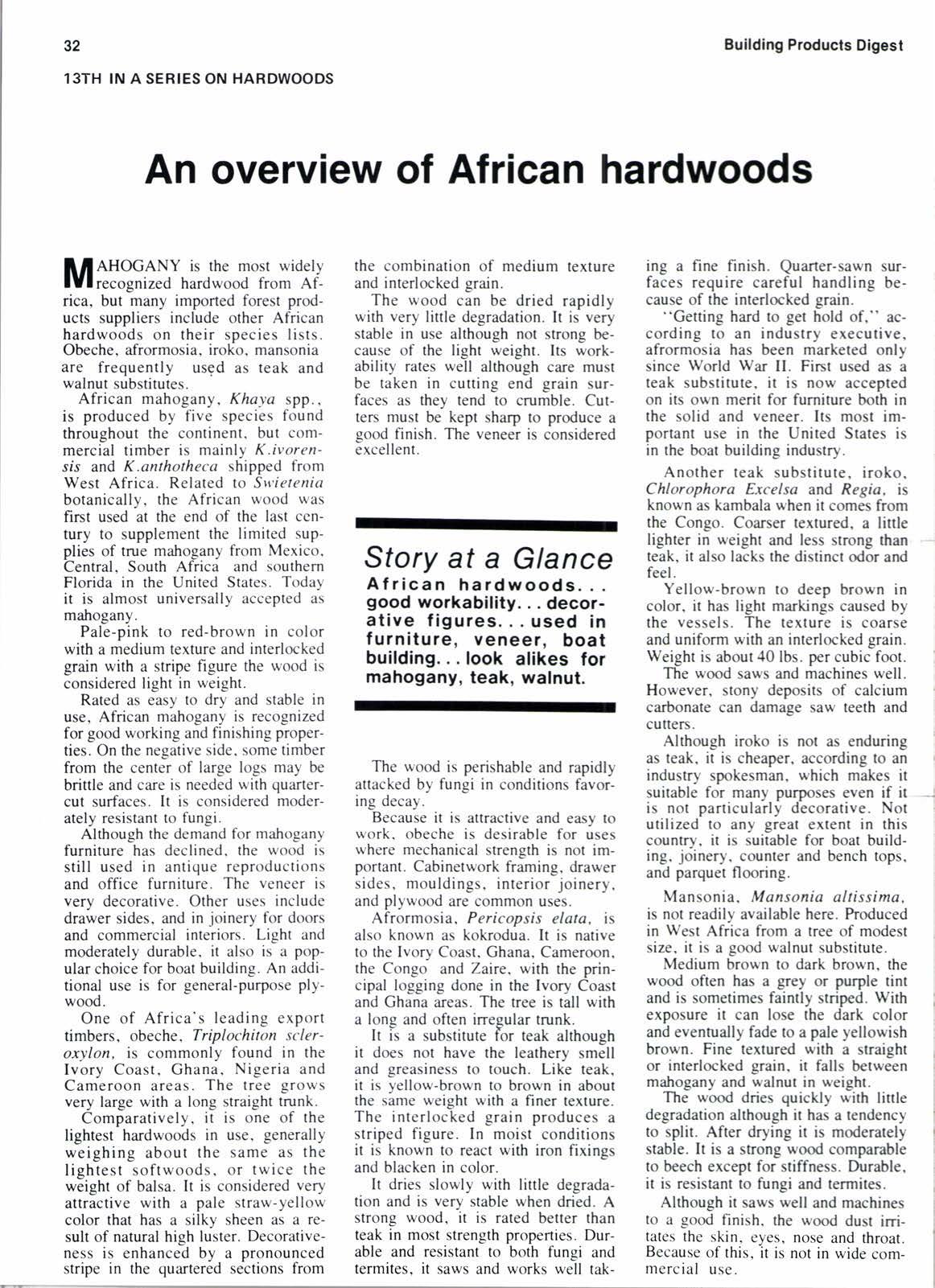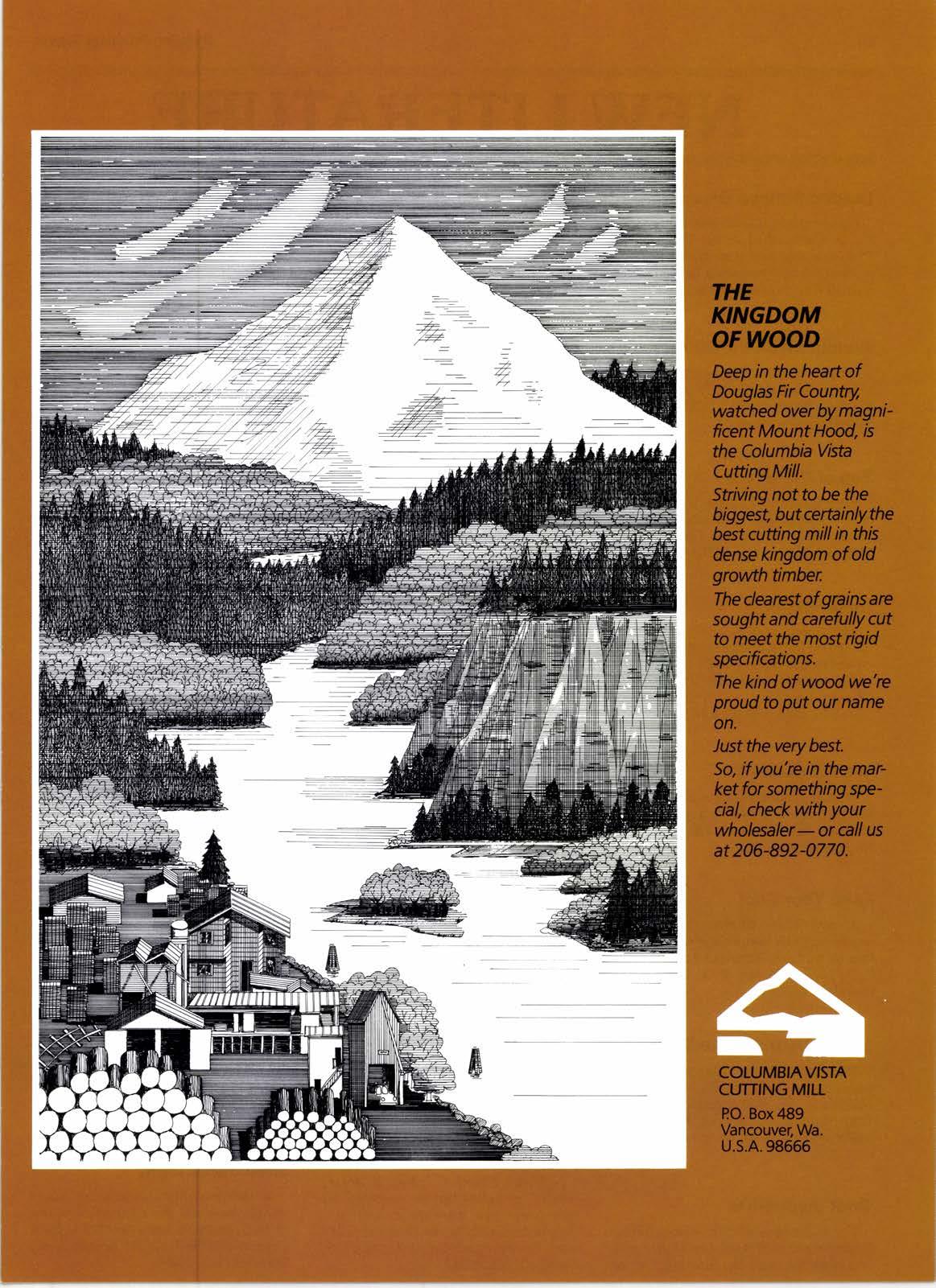
3 minute read
An overview of African hardwoods
ItAHOGANY is the most widely lUlrecosnized hardwood from Africa, but "many imported forest products suppliers include other African hardwoods on their species lists. Obeche, afrormosia, iroko, mansonia are frequently used as teak and walnut substitutes.
African mahogany, Khaya spp., is produced by five species found throughout the continent. but commercial timber is mainly K.ivoren' sis and K.anthotheca shipped from West Africa. Related to Sx'ietenia botanically, the African wood was fint used at the end of the last ccntury to supplement the limited supplies of true mahogany from Mexico. Central, South Africa and southem Florida in the United States. Today it is almost universally accepted as mahogany.
Pale-pink to red-brown in color with a medium texture and interlocked grain with a stripe figure the wood is considered light in weight.
Rated as easy to dry and stable in use, African mahogany is recognized for good working and finishing properties. On the negative side. some timber from the center of large logs may be brittle and care is needed with quartercut surfaces. It is considered moderately resistant to fungi.
Although the demand for mahogany furniture has declined. the wood is still used in antique reproductions and office furniture. The veneer is very decorative. Other uses include drawer sides, and in joinery for doors and commercial interiors. Light and moderately durable, it also is a popular choice for boat building. An additional use is for general-purpose plywood.
One of Africa's leading export timbers, obeche, Triplochiton scleroxylon, is commonly found in the Ivorv Coast. Ghana, Nigeria and Cameroon areas. The trEe grows very large with a long straight trunk.
Comparatively, it is one of the lightest hardwoods in use, generally weighing about the same as the lishtest softwoods, or twice the wEigtrt of balsa. It is considered very attractive with a pale straw-yellow color that has a silky sheen as a result of natural high luster. Decorativeness is enhanced by a pronounced stripe in the quafier6d settions from the combination of medium texture and interlocked grain.
The wood can be dried rapidly with very little degradation. It is very stable in use although not strong because of the light weight. Its workability rates well although care must be taken in cutting end grain surfaces as they tend to crumble. Cutters must be kept sharp to produce a sood finish. The veneer is considered 6xcellent.
Sfory at a Glance
African hardwoods... good workabality. decorative figures... used in f urniture, Yeneer, boat building... lookalikes for mahogany, teak, walnut.
The wood is perishable and rapidly attacked by fungi in conditions favoring decay.
Because it is attractive and easy to work. obeche is desirable for uses where mechanical strength is not important. Cabinetwork framing. drawer sides. mouldings. interior joinery. and plywood are common uses.
Afrormosia. Pericopsis elata, is also known as kokrodua. It is native to the Ivory Coast. Ghana, Cameroon, the Congo and Zaire, with the principal logging done in the lvory Coast and Ghana areas. The tree is tall with a lons and often irreeular trunk.
It is a substitute Ior teak although it does not have the leathery smell and greasiness to touch. Like teak, it is yellow-brown to brown in about the same weight with a finer texture. The interlocked grain produces a striped figure. In moist conditions it is known to react with iron fixings and blacken in color.
It dries slowly with little degradation and is very stable when dried. A strong wood, it is rated better than teak in most strength properties. Durable and resistant to both funei and termites. it saws and works *e'il tak- ing a fine finish. Quarter-sawn surfaces require careful handling because of the interlocked grain.
"Gening hard to get hold of," according to an industry executive. afrormosia has been marketed onlv since World War II. First used as i teak substitute. it is now accepted on its own merit for furnirure both in the solid and veneer. Its most important use in the United States is in the boat building industry.
Another teak substitute. iroko. Chlorophora Excelsa and Regia, is known as kambala when it comes from the Congo. Coarser textured, a little lighter in weight and less strong than teak. it also lacks the distinct odor and feel.
Yellow-brown to deep brown in color. it has light markings caused by the vessels. The texture is coarse and uniform with an interlocked grain. Weight is about 40 lbs. per cubic foot.
The wood saws and machines well. However, stony deposits of calcium carbonate can damage saw teeth and cuners.
Although iroko is not as enduring as teak. it is cheaper, according to an industry spokesman, which makes it suitable for many purposes even if it is not particularly decorative. Not utilized to any great extent in this country. it is suitable for boat building. joinery. counter and bench tops, and parquet flooring.
Mansonia. Mansonia altissima, is not readily available here. Produced in West Africa from a tree of modest size. it is a good walnut substitute.
Medium brown to dark brown. the wood often has a grey or purple tint and is sometimes faintly striped. With exposure it can lose ihe dirk color and eventually fade to a pale yellowish brown. Fine textured with a straight or interlocked grain, it falls between mahogany and walnut in weight.
The wood dries quickly with little degradation although it has a tendency to split. After drying it is moderately stable. It is a strong wood comparable to beech except for stiffness. Durable, it is resistant to fungi and termites.
Although it saws well and machines to a good finish, the wood dust irritates the skin, eyes. nose and throat. Because of this, it is not in wide commercial use.











